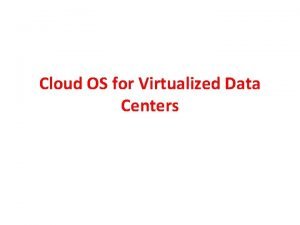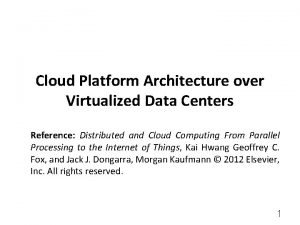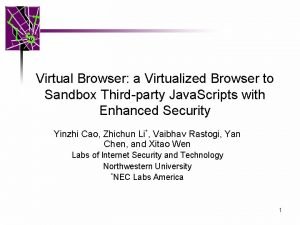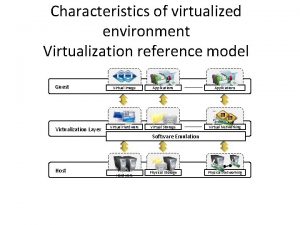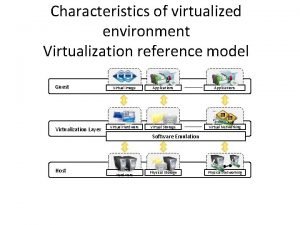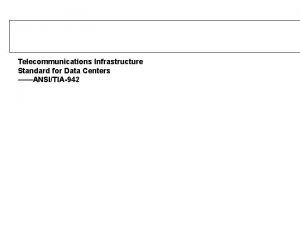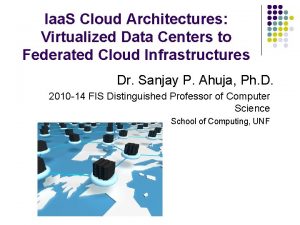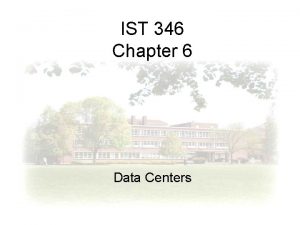Cloud OS for Virtualized Data Centers Cloud OS








- Slides: 8

Cloud OS for Virtualized Data Centers

Cloud OS for Virtualized Data Centers • Data centers must be virtualized to serve as cloud providers. • The table summarizes four virtual lnfra structure (VI) managers and OSes. • These VI managers and OSes are specially tailored for virtualizing data centers which own a large number of servers in clusters. • Nimbus, Eucalyptus, and Open Nebula are all open source software available to the general public. Only v. Sphere 4 is a proprietary OS for cloud resource virtualization and management over data centers. 2


Trust Management in Virtualized Data Centers • A VMM changes the computer architecture. • It provides a layer of software between the operating systems and system hardware to create one or more VMs on a single physical platform. • VMM can provide secure isolation and a VM accesses hardware resources through the control of the VMM. • The VMM is the base of the security of a virtual system. 4

Trust Management in Virtualized Data Centers • Normally, one VM is taken as a management VM to have some privileges such as creating, suspending, resuming, or deleting a VM. • Once a hacker successfully enters the VMM or management VM, the whole system is in danger.

VM-Based Intrusion Detection • Intrusion detection is used to recognize the unauthorized access. • An intrusion detection system (I DS) is built on operating systems, and is based on the characteristics of intrusion actions. • A typical I DS can be classified as a host-based IDS (HIDS) or a network based IDS (NIDS), depending on the data source. 6

VM-Based Intrusion Detection • A HIDS can be implemented on the monitored system. When the monitored system is haacked by hackers, the HI DS also faces the risk of being haacked. • A NI DS is based on the flow of network traffic which can’t detect fake actions. • Virtualization-based intrusion detection can isolate guest VMs on the same hardware platform. Even some VMs can be invaded successfully; they never influence other VMs

References 1. Kai Hwang, Geoffery C. Fox and Jack J. Dongarra, “Distributed and Cloud Computing: Clusters, Grids, Clouds and the Future of Internet”, 2. http: //klucloudseminar. weebly. com/ 3. http: //cloudcomputingnet. com/cloud-computing-deploymentmodels/ 4. http: //gcauble. com/products/cloud-computing/ 5. http: //www. levelcloud. net/why-levelcloud/cloud-educationcenter/advantages-and-disadvantages-of-cloud-computing/ 6. www. cse. unr. edu/~mgunes/cpe 401 sp 12/lect 15_cloud. ppt 7. http: //slideplayer. com/slide/5862268/ 8. https: //msdn. microsoft. com/en-us/magazine/dn 520239. aspx 9. http: //www. thoughtsoncloud. com/2014/01/cloud-computingdefined-characteristics-service-levels/ 8
 Cloud os for virtualized data centers
Cloud os for virtualized data centers Virtualized data center architecture in cloud
Virtualized data center architecture in cloud Virtualized data center characteristics
Virtualized data center characteristics Virtual browser security
Virtual browser security Virtualized customer premises equipment
Virtualized customer premises equipment Disadvantages of virtualization
Disadvantages of virtualization Machine reference model of execution virtualization
Machine reference model of execution virtualization Unique data centers
Unique data centers Unstructured cabling
Unstructured cabling
